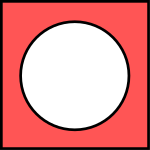Our website is made possible by displaying online advertisements to our visitors.
Please consider supporting us by disabling your ad blocker.
Negation
| NOT | |
|---|---|
 | |
| Definition | |
| Truth table | |
| Logic gate | |
| Normal forms | |
| Disjunctive | |
| Conjunctive | |
| Zhegalkin polynomial | |
| Post's lattices | |
| 0-preserving | no |
| 1-preserving | no |
| Monotone | no |
| Affine | yes |
| Self-dual | yes |
| Logical connectives | ||||||||||||||||||||||
|---|---|---|---|---|---|---|---|---|---|---|---|---|---|---|---|---|---|---|---|---|---|---|
|
||||||||||||||||||||||
| Related concepts | ||||||||||||||||||||||
| Applications | ||||||||||||||||||||||
|
| ||||||||||||||||||||||
In logic, negation, also called the logical not or logical complement, is an operation that takes a proposition to another proposition "not ", written , , [1] or .[citation needed] It is interpreted intuitively as being true when is false, and false when is true.[2][3] For example, if is "Spot runs", then "not " is "Spot does not run".
Negation is a unary logical connective. It may furthermore be applied not only to propositions, but also to notions, truth values, or semantic values more generally. In classical logic, negation is normally identified with the truth function that takes truth to falsity (and vice versa). In intuitionistic logic, according to the Brouwer–Heyting–Kolmogorov interpretation, the negation of a proposition is the proposition whose proofs are the refutations of .
An operand of a negation is a negand,[4] or negatum.[4]
- ^ Virtually all Turkish high school math textbooks use p' for negation due to the books handed out by the Ministry of National Education representing it as p'.
- ^ Weisstein, Eric W. "Negation". mathworld.wolfram.com. Retrieved 2 September 2020.
- ^ "Logic and Mathematical Statements - Worked Examples". www.math.toronto.edu. Retrieved 2 September 2020.
- ^ a b Beall, Jeffrey C. (2010). Logic: the basics (1. publ ed.). London: Routledge. p. 57. ISBN 978-0-203-85155-5.
Previous Page Next Page












































